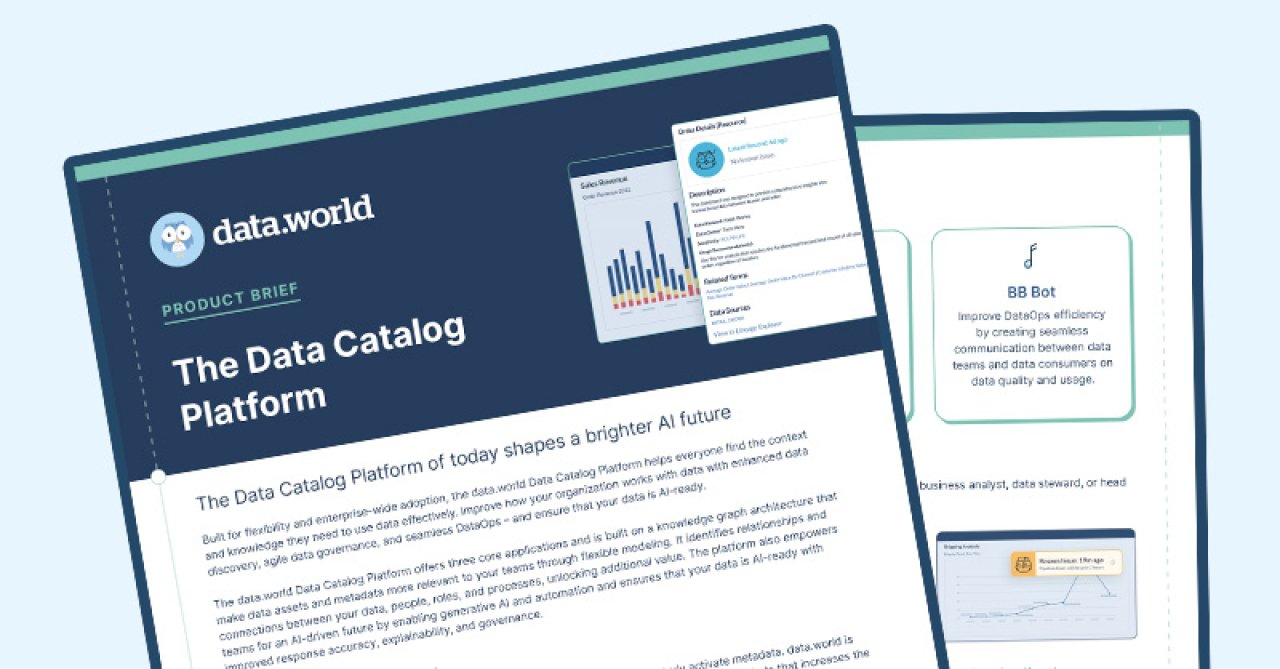







Sep 20, 2024

Jason Guarracino
Generative AI Product Leader

As data engineers and stewards, we're all too familiar with the challenge of managing complex data relationships. Our databases are bursting with information, but extracting meaningful insights often feels like searching for a needle in a digital haystack. That's where context engines come in.
Before we dive into context engines, let's talk about knowledge graphs. If you've been in the data world for a while, you've likely encountered them. At their core, knowledge graphs are a way of representing data that focuses on the relationships between entities. Instead of storing data in rigid tables, knowledge graphs use a more flexible, interconnected structure.
Imagine a vast web where every piece of data is a node, and the connections between these nodes represent relationships. This structure allows us to represent complex, real-world scenarios in a way that traditional databases simply can't match.
But here's the kicker – while knowledge graphs are powerful, they can be challenging to build, maintain, and query effectively. That's where context rngines come into play.
A context engine is not just another tool in your data toolkit – it's a fundamental shift in how we approach data management and analysis. At its core, a context engine is designed to understand and leverage the context in which data exists.
When we combine context engines with knowledge graphs, we create a synergy that's greater than the sum of its parts. Here's how:
Enhanced data integration: Context engines can automatically identify relationships between different data points, helping to build and enrich your knowledge graph with minimal manual intervention.
Intelligent querying: Traditional query languages can struggle with the complex structure of Knowledge Graphs. Context engines use natural language processing and semantic understanding to make querying intuitive and powerful.
Dynamic context adaptation: As new data flows in, context engines can automatically update the Knowledge Graph, ensuring it always represents the most current understanding of your data landscape.
One of the most exciting aspects of modern context engines is their native support for knowledge graph architecture. This isn't just bolted-on functionality – it's baked into the core of how these systems operate.
This native support means that every piece of data, every relationship, and every insight is stored in a way that preserves context and connections. It's like the difference between trying to understand a story by reading random sentences versus having the entire narrative laid out before you.
Data accuracy is our bread and butter as data professionals. Context engines bring a new level of sophistication to data validation through semantic understanding.
Instead of relying solely on predefined rules, Context engines can understand the meaning and context of data. This allows for more nuanced validation that can catch inconsistencies that might slip through traditional checks.
For example, a context engine might flag a data point that, while syntactically correct, doesn't make sense in the context of related information. This deep, contextual analysis not only improves data quality but can also uncover hidden insights and relationships.
Let's look at how this technology is making waves across different industries:
Healthcare: A major hospital network implements a context engine to manage patient data. By creating a knowledge graph of patient histories, treatments, and outcomes, medical staff have immediate access to it without any barriers to entry - they use their own natural language.
Finance: An investment firm uses a context engine to analyze market trends. By integrating data from multiple sources into a comprehensive Knowledge Graph, they can spot emerging opportunities and risks that would be nearly impossible to identify with traditional analysis.
E-commerce: A global retailer leverages a context engine to create a detailed Knowledge Graph of products, customer preferences, and market trends. This leads to more personalized recommendations and a significant increase in cross-selling success in their chat experiences.
If you're considering implementing a context engine in your organization, here are some best practices to keep in mind:
Start with a clear use case: Identify where improved contextual understanding will add the most value to your data operations.
Invest in data quality: While Context Engines can help improve data quality, starting with clean, well-structured data will yield the best results.
Collaborate across domains: Involve subject matter experts from different areas of your organization to ensure your knowledge graph accurately represents your business domain.
Plan for scale: As your knowledge graph grows, ensure your infrastructure can handle the increased complexity and query load.
Continuous learning: Set up processes to continuously validate and refine your Knowledge Graph based on new data and insights.
Start small: This is perhaps the most important best practice of all. “Pay as you go” is the model for success here.
As we look to the future, it's clear that context engines and knowledge graphs will play an increasingly central role in data management and analysis. We're moving towards a world where data doesn't just sit in silos waiting to be queried – it actively contributes to our understanding and decision-making processes.
To stay ahead of the curve, focus on developing a deep understanding of semantic technologies and graph databases. Familiarize yourself with natural language processing and machine learning techniques that can enhance contextual understanding.
The combination of context engines and knowledge graphs represents a paradigm shift in how we manage and extract value from data. As data professionals, we have the opportunity to lead this revolution, creating data ecosystems that are more intelligent, more intuitive, and more valuable than ever before.
Start exploring how you can integrate context engines into your data infrastructure today. Whether it's enhancing your current data management practices, building more comprehensive analytics capabilities, or laying the groundwork for AI-powered insights, the possibilities are endless.
The future of data is context-aware and deeply interconnected. Are you ready to unlock its full potential?

As data engineers and stewards, we're all too familiar with the challenge of managing complex data relationships. Our databases are bursting with information, but extracting meaningful insights often feels like searching for a needle in a digital haystack. That's where context engines come in.
Before we dive into context engines, let's talk about knowledge graphs. If you've been in the data world for a while, you've likely encountered them. At their core, knowledge graphs are a way of representing data that focuses on the relationships between entities. Instead of storing data in rigid tables, knowledge graphs use a more flexible, interconnected structure.
Imagine a vast web where every piece of data is a node, and the connections between these nodes represent relationships. This structure allows us to represent complex, real-world scenarios in a way that traditional databases simply can't match.
But here's the kicker – while knowledge graphs are powerful, they can be challenging to build, maintain, and query effectively. That's where context rngines come into play.
A context engine is not just another tool in your data toolkit – it's a fundamental shift in how we approach data management and analysis. At its core, a context engine is designed to understand and leverage the context in which data exists.
When we combine context engines with knowledge graphs, we create a synergy that's greater than the sum of its parts. Here's how:
Enhanced data integration: Context engines can automatically identify relationships between different data points, helping to build and enrich your knowledge graph with minimal manual intervention.
Intelligent querying: Traditional query languages can struggle with the complex structure of Knowledge Graphs. Context engines use natural language processing and semantic understanding to make querying intuitive and powerful.
Dynamic context adaptation: As new data flows in, context engines can automatically update the Knowledge Graph, ensuring it always represents the most current understanding of your data landscape.
One of the most exciting aspects of modern context engines is their native support for knowledge graph architecture. This isn't just bolted-on functionality – it's baked into the core of how these systems operate.
This native support means that every piece of data, every relationship, and every insight is stored in a way that preserves context and connections. It's like the difference between trying to understand a story by reading random sentences versus having the entire narrative laid out before you.
Data accuracy is our bread and butter as data professionals. Context engines bring a new level of sophistication to data validation through semantic understanding.
Instead of relying solely on predefined rules, Context engines can understand the meaning and context of data. This allows for more nuanced validation that can catch inconsistencies that might slip through traditional checks.
For example, a context engine might flag a data point that, while syntactically correct, doesn't make sense in the context of related information. This deep, contextual analysis not only improves data quality but can also uncover hidden insights and relationships.
Let's look at how this technology is making waves across different industries:
Healthcare: A major hospital network implements a context engine to manage patient data. By creating a knowledge graph of patient histories, treatments, and outcomes, medical staff have immediate access to it without any barriers to entry - they use their own natural language.
Finance: An investment firm uses a context engine to analyze market trends. By integrating data from multiple sources into a comprehensive Knowledge Graph, they can spot emerging opportunities and risks that would be nearly impossible to identify with traditional analysis.
E-commerce: A global retailer leverages a context engine to create a detailed Knowledge Graph of products, customer preferences, and market trends. This leads to more personalized recommendations and a significant increase in cross-selling success in their chat experiences.
If you're considering implementing a context engine in your organization, here are some best practices to keep in mind:
Start with a clear use case: Identify where improved contextual understanding will add the most value to your data operations.
Invest in data quality: While Context Engines can help improve data quality, starting with clean, well-structured data will yield the best results.
Collaborate across domains: Involve subject matter experts from different areas of your organization to ensure your knowledge graph accurately represents your business domain.
Plan for scale: As your knowledge graph grows, ensure your infrastructure can handle the increased complexity and query load.
Continuous learning: Set up processes to continuously validate and refine your Knowledge Graph based on new data and insights.
Start small: This is perhaps the most important best practice of all. “Pay as you go” is the model for success here.
As we look to the future, it's clear that context engines and knowledge graphs will play an increasingly central role in data management and analysis. We're moving towards a world where data doesn't just sit in silos waiting to be queried – it actively contributes to our understanding and decision-making processes.
To stay ahead of the curve, focus on developing a deep understanding of semantic technologies and graph databases. Familiarize yourself with natural language processing and machine learning techniques that can enhance contextual understanding.
The combination of context engines and knowledge graphs represents a paradigm shift in how we manage and extract value from data. As data professionals, we have the opportunity to lead this revolution, creating data ecosystems that are more intelligent, more intuitive, and more valuable than ever before.
Start exploring how you can integrate context engines into your data infrastructure today. Whether it's enhancing your current data management practices, building more comprehensive analytics capabilities, or laying the groundwork for AI-powered insights, the possibilities are endless.
The future of data is context-aware and deeply interconnected. Are you ready to unlock its full potential?